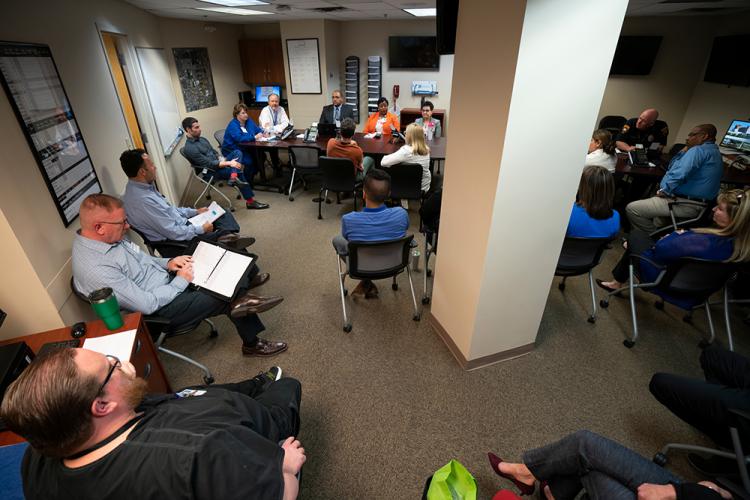
When circumstances are the most challenging, the team at JPS Health Network shines at its brightest.
As April came to an end and May began, JPS was challenged with a sudden increase in Emergency Department patients, causing a Code Yellow situation to be declared. About 20 percent more people than usual came to the hospital in need of care, stretching resources and putting pressure on team members.
To relieve the stress, other JPS departments sent all the on-duty help they could muster to the Emergency Department while many workers who had planned to enjoy their scheduled day off volunteered to come in to assist in care of patients. Meanwhile, health network Emergency Management leaders worked with community partners to line up help outside of the hospital’s four walls.
“We basically had a perfect storm of people who got very, very sick at the same time,” Lance Lynch, Director of Emergency Management, explained about the cause of the Code Yellow. “Not only were there a lot of folks in need of help, there were a lot of them with cases too serious to triage, treat and turn around quickly. A high percentage of them had to be admitted.”
When a Code Yellow is called, an organization-wide request is made for anyone who can help to join the effort. Christi Nguyen, Executive Director of Medical Surgical Services, said it’s heartwarming to see how many dedicated people who work at JPS answer the call of duty.
“Any time we’re in saturation, every single nursing unit works together, helping out any way they can,” Nguyen said. “It’s reassuring to know that when a department here needs help, there are always team members who are willing to jump in and assist. It says a lot about the people who work here.”
According to Jesse DeWaard, Executive Director of Emergency Services, an average day in the Emergency Department includes about 350 patient visits. During the Code Yellow, the volume shot up to a high of 428 people requiring care on the busiest day.
Lynch said 40 temporary patient beds were brought in by the North Central Texas Trauma Regional Advisory Council within an hour of the Code Yellow being declared and the agency offered to set up temporary triage facilities on the JPS Grounds. MedStar Mobile Healthcare volunteered to bring in an Ambus, which, as it sounds, is a bus that is used as an ambulance to handle up to 20 patients at once.
“We had things under control so we didn’t need the mobile hospital or the Ambus,” Lynch said. “But it was nice to know they were one phone call away if we did. Those things don’t happen without a lot of conversations and shaking hands in advance. Sometimes, it’s not if you know all the answers, it’s about knowing who to call when you need them.”
While leaders continued to work out logistics around a conference table, JPS team members made sure the plans were carried out.
Eric Ryan, an Emergency Medical Technician in the Clinical Decision Unit. was planning to enjoy his regular day off Tuesday when he got a call asking if he could come in to work. He volunteered to work a 12-hour extra shift.
“I went to the Emergency Department and sat with patients who needed to be observed,” said Ryan, who added he never even considered saying no. “When the ER is going through a hard time, we’re all going through a hard time. I was a little bit worn out, but I felt like I did the right thing, and that’s what’s important.”
Transportation Services was already shorthanded before the Code Yellow was called, with only three patient transporters on duty as opposed to its normal six day shift workers, according to Geneva Crow, Manager of Patient Transport and Mail. Those workers were taken off their normal rounds, transporting about 160 patients a day, and sent to the Emergency Department to help out, requiring nurses in other departments to handle transportation of patients once they were admitted, transferred or discharged.
Transporter Doris Sam was scheduled to be off Tuesday. But she volunteered to come in for five hours, pushing wheelchairs to take patients where they need to be.
“I just enjoy feeling like I was able to help out,” Sam explained when asked why she sacrificed her day off. “They had a lot of people in the hospital. If I can do something about it, why wouldn’t I?”
Lynch said he was impressed at how quickly team members were able to resolve the Code Yellow situation. When it was called, health network leaders thought it would take several days to clear the backlog of patients. In the end, it took about two, thanks to help from team members and community partners. While the 48 hour or so the Code Yellow was in effect was a tough time for those who pitched in, the experience was an invaluable lesson, he said.
“The focus of Emergency Management is preparedness,” Lynch said. “So every time we have an event like this is a chance for us to learn and be more prepared for the future. We can figure out what we did wrong and try to make it right and what we did right to try to make it even better.”
